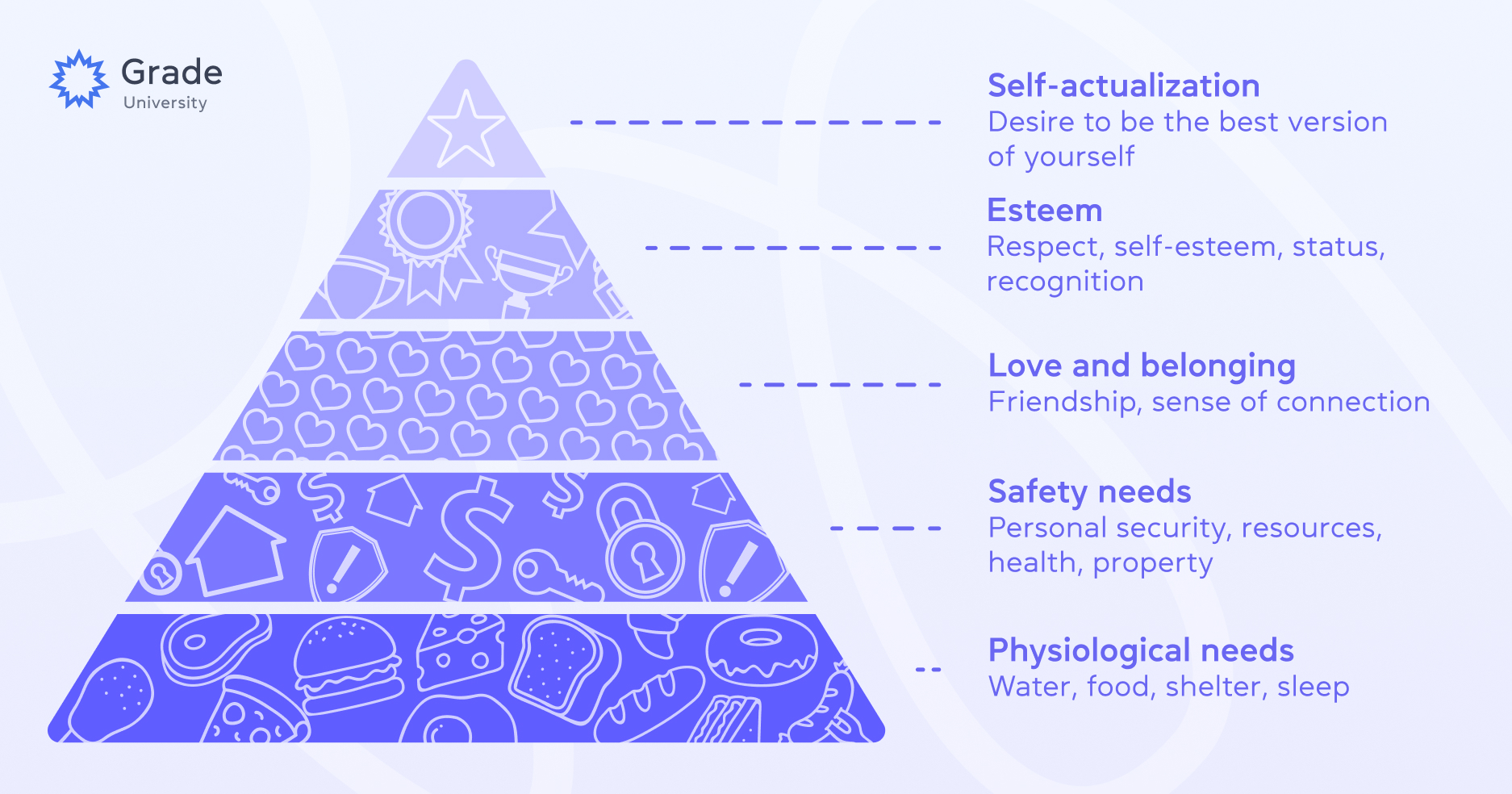Common challenges students face in speaking English and how to overcome them
- Speaking
- Tips & Strategies
- Methodology

24.01.2024
Students frequently fail to achieve their goals, no matter how hard both they and their ESL teacher try. You keep asking yourself the same questions: does the presentation work well; do they have enough freer practice? And even though the answers are “yes”, your students seem unmotivated and slow.
If it is your case, it might be a sign to refer to Maslow’s pyramid, analyze the students’ needs and see whether it is even possible for them to reach that success in learning English.
In this article, Grade University community will share our idea of Maslow’s hierarchy application to ESL teaching.
Abraham Maslow proposed a hierarchy of essentials for humans, with physiological (survival) needs at the base and more intellectual and mental "self-actualization" needs at the top.
Therefore, there are five levels of human needs according to Maslow’s hierarchy.

Maslow said that survival requirements must be met before a person can satisfy their higher-level needs. The further you go up the hierarchy, the more difficult it is to meet the requirements of each level. Even though these requirements seem not complicated, they are hard to fulfill because of the interpersonal and environmental constraints that we inevitably have to go through to succeed.
The needs that are situated at the top are considered to be more psychological and long-term while those at the bottom are physiological and immediate, primarily connected to survival.
However, how is any of that information related to the topic of ESL teaching?
In the hierarchy of needs, the students’ physiological needs come first and are of the greatest significance.
These are the most fundamental ones that are necessary for existence. This might involve shelter, food, and water. In cases where students’ physiological needs are not satisfied, teachers should be aware that their attention may be disrupted. No wonder; nobody can really study when they are hungry or tired because of the lack of proper sleep.
Say goodbye to challenging teen classes and teach with confidence
But how can educators make sure that the physiological needs of their students are met? Ensure that you have enough space, lighting, good ventilation, drinking water, restroom breaks, etc.
Also, you may always talk to parents if you see that your student is constantly sleepy or anxious about something.
The bottom line is that the learning process can’t be effective if the physiological needs are not fulfilled.
The second level is defined by safety needs, which are essential to every person’s success.
Therefore, if you see some cases of bullying or any kind of aggressive behavior within the class, react immediately.
Also, Maslow’s pyramid explains why it is crucial to build rapport with your students and comfort them if needed.
According to Maslow's hierarchy, students need to experience love and belonging at level three. If you want the learning process to move smoothly and effectively, students need to feel like they belong and can relate to other students.
Students should feel that they matter both as individuals and as members of the group. It is much harder to fulfill the third level but still not impossible for an ESL teacher.
By using inclusive learning strategies like group and pair work, establishing reasonable ground rules regarding respect for all students and spending some quality learning time together, you may support a friendly, accepting, and trustful atmosphere in your classroom.
After the student’s prior needs are satisfied, they can go to the following level: the need of self-confidence, or self-esteem.
At this stage, the learner is more open to learning and desires to develop positive self-esteem via accomplishment and praise. Students now have faith in their capacity to study and have become self-assured enough to accept responsibilities for their own education.
You can engage your students in learner-centered activities like peer teaching and peer evaluation to increase their level of self-confidence and therefore meet the requirements of the fourth level.
Under no circumstances should you differentiate students or make them doubt their abilities to study English. If an ESL teacher does that at some point, it is extremely hard to persuade students that he or she is capable enough.
When it comes to higher levels of Maslow’s pyramid, an ESL teacher has to consider the psychological state of the students and give support if the student lacks self-esteem.

The fifth level is all about self-actualization.
The hierarchy states that in the fifth level, students actively seek out opportunities to study and find fulfillment. At this level, students will set more challenging learning objectives and work hard to reach them. These objectives may vary from getting the best mark on their assignments to winning some kind of competition.
We need no statistics to say that this is definitely not a priority for everybody in the class. Moreover, such an attitude is even rare.
But as soon as we start reflecting on the reasons, we will soon realize that it is practically impossible for the student to reach the fifth stage if he or she:
The reasons may vary dramatically depending on the age of your students and their background; however, if your students can’t succeed, Maslow’s pyramid may provide some clues that will help you to understand the particular situation better and offer a reasonable solution.

Useful techniques for providing language feedback
Find outSure, dealing with certain problems at each level requires specific ESL qualifications. So, if you feel like looking for the most effective solutions to the most common classroom problems, we are ready to help. By the way, you can try our course ‘The Motivated Teen’, which is built around Maslow's Pyramid.
Arina Kravchenko
Author
Teacher of General English & IELTS
Comments
Leave your comment